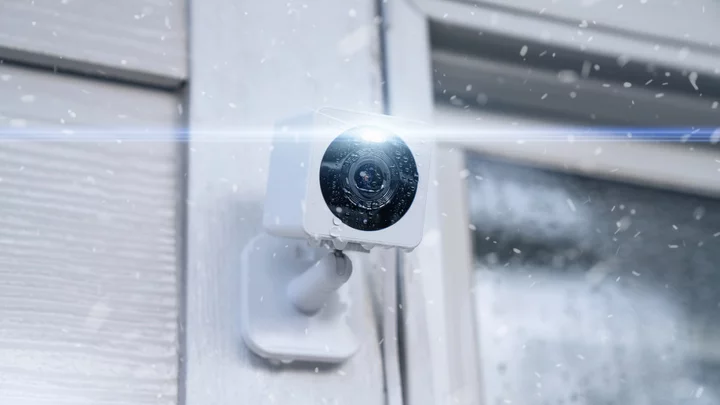If anyone ever stole a package from your porch or broke into your car while it was in your driveway, the perpetrator likely disappeared long before you even knew you were a victim. You also likely never found out who committed the deed. If this sounds familiar, you should consider investing in an outdoor security camera.
These rugged smart home devices, which can withstand rain, snow, and extreme temperatures, typically connect to your home Wi-Fi network and allow you to view live video footage of activities occurring outside your home. They can also send an alert to your phone when someone or something is out there, record video of the event, and, depending on features, let you speak with whoever is on your property, all without requiring you to open your door (or even be inside your house).
Read on to find out what features to look for in an outdoor security camera, and check out our top picks. Note that several of the cameras on this list are suitable for use both indoors and outdoors. If you want a model specifically for keeping tabs on what goes on inside your home, head over to our list of the best indoor home security cameras.
How Do Outdoor Security Cameras Work?
Most smart outdoor security cameras use a Wi-Fi radio to connect to your home network, enabling you to access them from anywhere via a mobile app. Some models use Ethernet, Bluetooth, Z-Wave, or a proprietary wireless technology to connect to a mobile app or a dedicated hub.
Wi-Fi cameras are simpler to install than their wired counterparts because you don't have to place them near an Ethernet port or run any wiring. Battery-powered Wi-Fi cameras are the easiest to install because you can put them just about anywhere (as long as they can connect to your network) without having to snake a power cable around your home to plug into an outlet. These types of cameras typically use batteries that you can easily pop out and recharge with a USB cable, but they tend to drain quickly in colder weather. Bluetooth cameras are also simple to install, but you have to stay within 30 feet or so to connect to them via your phone.
Look for an outdoor Wi-Fi camera that can connect to either the 2.4GHz or 5GHz radio band to alleviate network congestion. If you have trouble getting a good signal outside, try boosting it with a wireless range extender.
Google Nest Cam (Outdoor or Indoor, Battery)What Type of Weather Can Outdoor Security Cameras Handle?
Any outdoor camera worth its salt must be able to withstand exposure to the elements and should carry an Ingress Protection (IP) rating. IP ratings contain two digits that tell you just how well the camera holds up under most weather conditions. The first digit following the IP prefix tells you how resistant the camera is to the ingress of solid objects such as wind-blown dust and ranges from 0 (no protection) to 6 (total protection against dust and dirt). The second describes how resistant the camera is to moisture and ranges from 0 (no protection) to 9 (protected against close-range, high-pressure sprays from all angles).
Most outdoor security cameras have at least an IP66 rating, which means they offer complete protection from dust ingress and can handle water jets from any direction. Although you shouldn't submerge them in water, they are typically safe from blowing rain, snow, and sleet.
The best home security cameras for 2019 — Clarification PleaseWhat Resolution Should an Outdoor Security Camera Have?
An outdoor security camera isn't very useful if you can't recognize who or what the camera captures. A 1080p video camera offers more detail than a 720p camera and is the most popular resolution for these devices; 1080p recordings don't require a lot of storage and are viewable on nearly every phone, tablet, and PC.
Cameras that capture 4K (Ultra HD) or 2K video are also available, but you need a strong network connection to stream such high-res video without choppiness or lag, plus lots of room to store recordings; that last requirement may result in expensive cloud storage fees.
No matter the resolution, try to choose a camera with a relatively wide field of view and make sure it can capture clear night-vision video. Most cameras use IR (infrared) LEDs to deliver black-and-white night video, but a few use white light to deliver full-color night video. Look for a camera with a night vision range of at least 30 feet.
Can Outdoor Security Cameras Detect Motion and Sound?
Nearly all outdoor security cameras feature a sensor that triggers the camera to record video when it detects motion. Most can also send a push alert to your phone (or an email) when the activity occurs. For an extra layer of security, look for a camera that can detect sound; these cameras can alert you if somebody is out there even if they're out of range of the camera lens and the motion sensor. Fair warning: You probably have to tweak the sound sensitivity settings to avoid alerts from barking dogs, loud cars, and other random noises.
Some security cameras include a floodlight that can automatically light up driveways, pools, and other parts of your property when they detect motion. These devices are much brighter than so-called spotlight models. You can read about them in our separate roundup of the best floodlight cameras.
If the camera has a microphone for sound detection, it likely has a two-way audio system that lets you speak with (and listen to) whoever is outside. This is useful for dealing with annoying solicitors as well as scaring off porch pirates and other unwanted visitors. For more ways to see and communicate directly with the person at your door, check out our list of the best video doorbells.
Wyze Cam Pan v3How Do Security Cameras Store Video?
Cameras store video recordings in several ways. Many offer free cloud storage for a limited number of days (typically seven) before it is overwritten or deleted, while others are strictly subscription-based. If you require more than a week's worth of video storage, you can subscribe to a 30-day plan to avoid worrying about losing important footage before you get to review and download it.
If you're concerned about privacy and would rather not store your video in the cloud, look for a camera that offers a local storage option via a microSD card slot. A few cameras let you save video recordings to a portable USB or NAS drive, but these devices are rare.
And if you want the ability to go back and see everything, look for a camera that offers a CVR (Continuous Video Recording) plan. With this option, the camera records continuously and stores up to 30 days of 24/7 video in the cloud.
What Else Do Outdoor Security Cameras Work With?
Many outdoor cameras do more than just record video and send alerts; they also integrate with other smart devices. Many recent outdoor Wi-Fi cameras support IFTTT, an internet service that lets you create applets that link the camera with other IFTTT-enabled devices. For example, you can configure a smart plug to turn on a lamp indoors or activate an external siren when the camera detects motion.
Support for Amazon Alexa and Google Assistant voice commands is also increasingly common. These integrations allow you to, for example, display video from the camera on a compatible smart display. If you have a home automation hub, look for a camera that works with your existing setup. That way you can integrate your security camera with even more smart devices like door locks.
We haven't seen any that run on the Matter platform yet, but that's surely going to happen at some point.
How Much Should You Spend on an Outdoor Security Camera?
Outdoor security cameras are generally more expensive than their indoor counterparts. They can range in price from around $50 up to a few hundred dollars or more depending on features. Plenty of affordable cameras offer good video performance, but, as with just about any smart device, you typically pay more for features such as motion-tracking, facial recognition, cellular connectivity, time-lapse recording, pan and tilt controls, additional storage options, and rechargeable battery power.
Check out our Readers' Choice Awards to see which security cameras and brands other PCMag readers trust most. Once you find the camera for your home, check out our tips for setting it up.
For an even more advanced way to keep a set of eyes on your home, both indoors and out, explore our picks for the best smart home security systems. And if you prefer to go the DIY route, check out our tips for building your own home security system.









